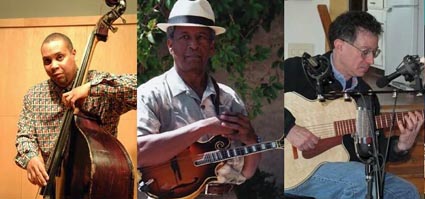« New from V-picks: Jalapeno |
Main
| Guitar to mandolin »
 October 3, 2013 | The Evolution of the Jazz Mandolin with Tim Porter October 3, 2013 | The Evolution of the Jazz Mandolin with Tim Porter
Fascinating lecture/demonstration going on this month in the National Jazz Museum in Harlem in New York. The five part series has already started, but you can still catch the last sessions if you're in or near the Big Apple!
Jazz for Curious Listeners:
The Evolution of the Jazz Mandolin with Tim Porter

All of the sessions will feature live performances of tunes appropriate to the period with Tim Porter on mandolin, Joe Selly on guitar and Santi Debriano on bass.
7:00 - 8:30pm
Location: The National Jazz Museum in Harlem
104 East 126th Street, Suite 2C
Donation Suggested | For more information: 212-348-8300
Session dates & descriptions
Tuesday, October 1
"Once Upon a Time"
The first segment on the evolution of jazz mandolin will examine the 17th and 18th century origins of the mandolin in the Mediterranean to its 19th and early 20th century arrival in North and South America.
Tuesday, October 8
"Two Step" Ragtime and Choro
Part two of the jazz mandolin sessions will discuss the simultaneous popularity of ragtime in America and choro in Brazil. The syncopated or "ragged" rhythms of ragtime laid the groundwork for jazz during the early years of the 20th century. At the same time, choro music, often played on mandolin, was being composed and played in Brazil.
Tuesday, October 15
"The Mandolins are coming! The Roaring 20's to the Big War"
While choro music was becoming the rage in Brazil, Dave Apollon, a Russian immigrant and mandolin virtuoso, was carving out a major place for himself and the mandolin in the emerging world of jazz. In the third segment of the jazz mandolin series, we discuss the explosion of mandolin playing and the development of mandolin groups in the teens and 1920's. The growing popularity of the instrument led the Gibson musical instrument company to launch a marketing campaign to sell the instrument and produce a family of instruments paralleling those in the violin family, with mandolin, mandola, mando cello, and mando bass.
Tuesday, October 22
"Triad and Trifecta" Swing, More Blues and Bluegrass
The mandolin music of the 1930's, 40's , 50's, and 60's was influenced in large part by six musicians: Dave Apollon, Bill Monroe, Yank Rachell, Howard Armstrong, Tiny Moore, and Jethro Burns. The fourth segment in our mandolin series takes a look at these masters and the spreading of mandolin to blues, bluegrass and swing. Yank Rachell and Howard Armstrong were separately employing the instrument in blues, folk music, and popular music of the time. Bill Monroe was developing a different style of music called bluegrass, which combines some of the traditional music of the British Isles that survived in Appalachia with elements of jazz. Billie "Tiny" Moore was a Western swing musician who played the electric mandolin with legend Bob Wills and the Texas Playboys in the 1940s. Kenneth C. "Jethro" Burns, born the same year as Moore, was an extremely influential mandolinist who performed primarily in a country music setting where he introduced many country mandolinists to sophisticated jazz harmonies and improvisational techniques as well as the music of Duke Ellington, Django Reinhardt, and Cole Porter.
Tuesday, October 29
"Fast Forward to Today's Foremost" Blues, Bebop and Beyond
The last session in our series on the jazz mandolin will focus on the further development of mandolin jazz through Swing, Bebop, and the present with discussion on the contemporary mandolinists such as Andy Statman, Mike Marshall, David Grisman, Barry Mitterhoff, Peter Ostrousko, Sam Bush, Don Stiernberg, Jamie Masefield (of the Jazz Mandolin Project), and Chris Thile.
More information:
Website: The National Jazz Museum in Harlem
Facebook Events page: The National Jazz Museum in Harlem
Artist Bio: Tim Porter
Posted by Ted at October 3, 2013 6:10 AM

Disclaimer: In the 'Information Age' of the 21st Century,
any fool with a computer, a modem, and an idea can
become a self-professed 'expert." This site does not
come equipped with 'discernment.'
|



